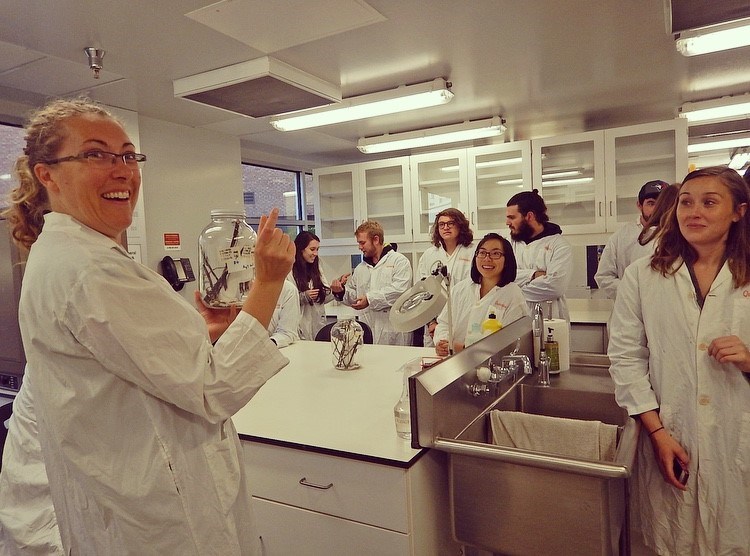Amanda Roe was never the type to play with dolls or live in the world of make-believe.
Growing up on a farm in southern Alberta, she spent her adolescent days exploring the world around her, carting around a bucket of bugs and collecting treasures from the surrounding countryside.
The allure of the natural world stayed with her as she grew up, but it wasn’t until she was a student at the University of Alberta, taking a course on insects, that she had her epiphany.
Gathering forest specimens as part of a field study, Roe spotted an “absolutely stunning moth” resting on a leaf, and she knew, instinctively, that bugs would figure prominently in her future.
“You could spend your entire career learning about insects and you couldn't even know all of them in one small area, let alone the globe, so there's always something new to learn about insects,” said Roe, who completed her PhD on Dioryctria, a pest of conifer trees, in 2006.
“For me, that's the essence of science – knowing that you're discovering new knowledge, you're discovering something no one else knows, and then you get to share that story with other people.
“That process of discovery and sharing… is just telling stories about the natural world.”
Since 2016, Roe has applied that knowledge to her work at the Great Lakes Forestry Centre (GLFC) in Sault Ste. Marie where she conducts research into applied pest management.
She also serves as the scientific lead for the Insect Production and Quarantine Laboratories (IPQL) and chairs the Insect Rearing Advisory Group.
Her goal is to “understand how insects behave and interact with the world around them” – what plants they eat or what impact the weather may have on them – and apply that to manage insect populations.
Want to read more stories about business in the North? Subscribe to our newsletter.
Bugs in southern Ontario, for example, may be different than bugs in Northern Ontario, Roe noted. But if we only study bugs from the southern part of the province, we could be missing out on important information that helps us deal with bug populations here.
Information gleaned from Roe’s research can also help us address the impact of invasive species that aren’t native to Northern Ontario.
“Those types of information can help us understand where bugs are, where they may go, and how their populations might change over time,” she said.
Roe said she feels fortunate to have been encouraged in her love of science – first by her parents and later by helpful teachers – and provided with lots of opportunity to explore her options.
Yet women tend to be largely underrepresented in careers in science, technology, engineering and math (STEM).
According to Statistics Canada, in 2016, “women made up 34 per cent of STEM bachelor’s degree holders and 23 per cent of science and technology workers among Canadians aged 25 to 64.”
In Roe’s experience, a big part of the issue comes later on in a woman’s career, after she’s completed her education and is seeking work in her field.
Many scientists tend to find their life partners within their scientific circle, she noted. Yet it can be difficult for two partners to both find work in their respective fields in the same community, something known in the field as the “two-body problem.”
In Roe’s case, she considers it fortunate, but extremely rare, that she and her husband, who’s also an entomologist at the GLFC, are both employed in their chosen sectors.
“I think is a huge barrier for many people, and often, statistically, it's often the woman whose career ends up becoming delayed or altered in favour of her partner's,” Roe said.
The problem is further exacerbated once those couples start to have families and the woman has to take time off to give birth.
Roe believes more supports are needed to ensure women won’t feel childrearing is a count against them in their careers.
“That speaks to a bigger picture of wanting to support and maintain diversity within your community,” Roe said.
“Everything we know is that diversity of ideas, diversity of backgrounds is critical for any field, and in particular science, which is based on ideas and different points of view and different solutions to challenges.”
She’s heartened that today’s schooling and programming is supportive of encouraging girls and women in STEM, including her own two young girls, one of whom is showing an early interest in science, while the other is passionate about math.
Kids are naturally curious, she noted, and so she suggests the best thing parents can do to stimulate that search for knowledge is simply to take kids outside.
Let them play in the mud, urge them to pick up caterpillars and other creepy crawlies, and help them talk about what they find.
That simple act can do wonders for encouraging a new generation of both women and men to consider careers in STEM fields, which continue to be important areas of work and study.
“If you don't expose them to that then they aren't going to grow up with an appreciation for it,” Roe said.
“You save what you love, and you care about what you love, and if they don't care about it, then there's going to be no interest in preserving the natural world.”




